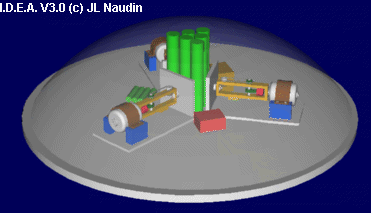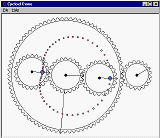

Inertial Propulsion Engines
created on 07-29-98 - JLN Labs
- last update on 02-09-02
All informations in this
page are published free and are intended for private/educational
purposes and not for commercial applications
 "Isolated systems
which are automatically propelled by inertia forces"
FR2651279 by Lafforgue
Jean-Claude
"Isolated systems
which are automatically propelled by inertia forces"
FR2651279 by Lafforgue
Jean-Claude The
Impulse Drive Experiment
by J-L Naudin, Easy to build, test
by yourself.
The
Impulse Drive Experiment
by J-L Naudin, Easy to build, test
by yourself. The
Cycloid software simulator from
Simon Tillson
The
Cycloid software simulator from
Simon TillsonAbout Inertia : Suggested document to be read
Questions and Answers about the Origin of Inertia and the Zero-Point Field by the CIPA
Inertia theory: Magic roundabout by Paul Davies on the meaning of Mach's principle
Origin of Inertia " How inertia originates in the cosmos. " by James F. Woodward
Radiation reaction " The weird world of radiation reactions where you seem to get energy from nowhere and things move before you begin to push them. " by James F. Woodward
Transient Mass Fluctuations " Where it's all put together and we end up doing strange things. " by James F. Woodward
Woodward and ZPE by Robert Stirniman
| Method
and apparatus for generating propulsive forces
without the ejection of propellant No. Publication (Sec.) :US6098924 Date de publication :2000-08-08 Inventeur :MAHOOD THOMAS (US); WOODWARD JAMES (US) D�posant :CALIFORNIA STATE UNIVERSITY FU (US) Abstract : Mach's principle and local Lorentz-invariance together yield the prediction of transient rest mass fluctuations in accelerated objects. These restmass fluctuations, in both principle and practice, can be quite large and, in principle at least, negative. They suggest that exotic space time transport devices may be feasible, the least exotic being "impulse engines", devices that can produce accelerations without ejecting any material exhaust. Such "impulse engines" rely on inducing transient mass fluctuations in conventional electrical circuit components and combining them with a mechanically coupled pulsed thrust to produce propulsive forces without the ejection of any propellant. The invention comprises a method of producing propellant-less thrust by using force transducers (piezoelectric devices or their magnetic equivalents) attached to resonant mechanical structures. The force transducers are driven by two phase-locked voltage waveforms so that the transient mass fluctuation and mechanical excursion needed to produce a stationary thrust are both produced in the transducer itself. |
AIAA-2001-3908 : Tests of Mach's Principle with a Mechanical Oscillator : J. Cramer, Univ. of Washington, Seattle, WA
Analysis of Woodward's Piezoelectric Capacitor Thruster by Steve Burns ( PDF document )
MASS TRANSFER 'An Introduction' based on experimental work at the University of Sussex by Prof. E.R. Laithwaite
Inertia or Reaction ? by Harold Haspden
Reactionless propulsion and Active Force by Alexander Frolov
The Gravitation conception and experiment by Alexander Frolov
See the Field Effect Propulsion page
![]() Email
: [email protected]
Email
: [email protected]
Return to the Advanced Propulsion page